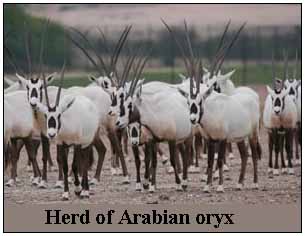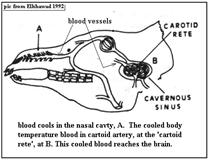Amazing Facts About Wildlife
Keeping cool in the desert
Animals that survive in harsh environments display ingenious forms of adaptation, says S.Ananthanarayanan.
An example of adaptation of extreme conditions is the Arabian oryx or the large black and white antelope of the arid areas of Africa. This instance of evolution ‘to the very edge’, which even sports a built-in refrigeration system to save its hypothalamus,
was officially declared extinct 40 years ago. But fortunately, in the early 1960s, the late Sheikh Zayed bin Sultan Al Nahyan, founder of the UAE, arranged for two breeding pairs of the Arabian Oryx to be caught and preserved as the nucleus of a captive-breeding
programme

The release of captive-born Arabian oryx individuals into suitable habitats was carefully planned and started in 2007. With close monitoring, the programme has been effective and it is estimated that there are now 1,100 Arabian oxyr in the wild and 6,000 in
zoos, reserves and in private collections.
The places the oryx inhabits see effectively no rainfall, no vegetation except patches of grass and shrubs and daytime temperatures higher than 45°C. The oryx, then, has adapted to need no surface water for survival. The only moisture is from the grass and
shrubs, on which the oryx grazes during the night. By feeding during the night, the orxy saves on valuable fluid loss and also benefits from greater moisture content of grass. In the day, the oryx aligns itself to present the least area to the sun and will
seek shady spots or lie in cooler mud to shed heat. The oryx’ white belly also helps deflect the heat from the hot, desert sand.
Shedding heat
The great challenge, in fact, is to shed heat and maintain body temperature. Nature has two main categories of animals, the warm blooded and the cold blooded. Being warm blooded means the animal has to maintain its body temperature, which needs energy – burning
calories when it is cold and usually cooling by sweating when it is warm. The cold blooded animal simply takes the temperature of the environment and can manage with much less calorie intake. But metabolic processes are slower at low temperatures and cold
blooded animals often spend long periods in hibernation, getting active only when the environment warms up. Warm blooded animals are active through the year and are equipped to exploit the surroundings for more nutrition.
The problem arises when warm blooded animals need to deal with extreme temperatures. When temperatures are high, animals usually cool down by sweating and allowing evaporating fluids to carry away excess heat. But where there is a need to conserve even moisture,
then, one way of coping is to simply not cool down, but allow the body temperature to rise! This is a case of behaving like a cold blooded animal and (in a warm blooded animal) is called heterothermy, as opposed to homeothermy, or constant temperature, on
the one hand and poikilothermy, which is temperature varying with the environment, on the other.
Arabian oryx
Various studies have shed light on how the oryx, which manages with the least moisture intake of the all desert animals, deals with high temperatures. One study, in 2003, revealed that the oryx body temperature varies between 36°C in the morning to over 40°C
in the evening. The lowest temperature in the summer, in fact, was lower in the summer than in the winter, apparently to permit more heat trapping in the summer. But the maximum body temperatures are known to rise as high as 45°C, a temperature that would
be fatal to most other animals.
Warm blooded animals, which benefit from higher rates metabolism have evolved so that many vital functions depend on temperatures staying within narrow limits. Very high temperatures can thus threaten vital functions, the most sensitive being the central nervous
system or parts of the brain. Allowing the body to heat up could thus be dangerous when the ambient goes higher than 45 °C.
The Arabian oryx, and other desert animals, like camels often need to spend hours on end at temperatures as high as this. With the body temperature also rising, how do they avoid brain damage? The answer is found to be through a system of cooling the blood
that goes to the brain by a slightly energy consuming, but effective cooling device – the passage of air through the nose.
In the oryx, and the camel, the blood to the brain passes through a mesh of blood vessels in the animals’ sinus, where the blood comes into contact with blood vessels carrying bloods that is returning after passing by the nasal cavity. In the nasal cavity,
there is very economical evaporative cooling, which cools the blood in the surrounding blood vessels. This cooled blood comes into the sinus cavity and here it absorbs heat from blood going to the brain. It is also possible that the sinus cavity is anyway
cooler because of air from the nostrils expanding into the cavity. The carotid artery also seems to be in the form of crisscross of blood vessels in this region, to act as an efficient heat exchanger. And the effect is that despite all the warming of the animals’
blood, the brain gets temperature regulated supply and stays cool. Even when running for long, the faster breathing leads to more cooling and protects the brain despite still higher body temperature. "What is more, when there is greater rise in body temperature,
the vein system in the head region contracts and expands, so that more of the blood that has been cooled in the nasal passage must flow through the carotid heat exchanger, to assure cooling of blood supply to the brain."

The arrangement is highly efficient, as the cooling in the nasal passage is immediately absorbed by surrounding blood flow, and then transferred to the limited blood supply specifically for the temperature sensitive parts of the brain. The arrangements thus
permits saving of scarce moisture, by allowing body temperature to rise and yet avoiding the effect of rising temperature on the brain.
[the writer can be contacted at simplescience@gmail.com]
|